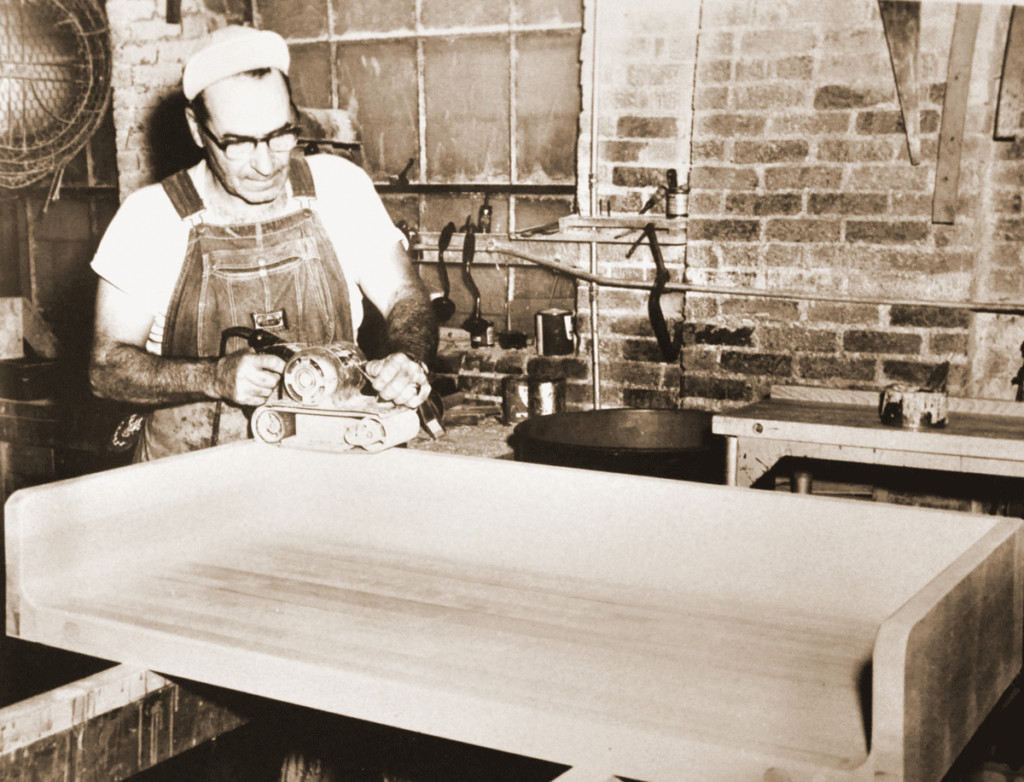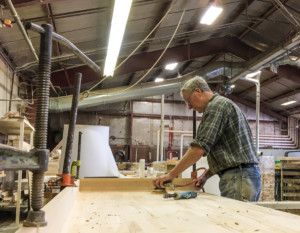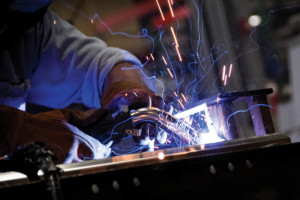What do celebrity chefs like Bobby Flay, home cooks inspired by the Food Network, and even royalty like Kate Middleton, the Princess of Wales, share in their kitchens? Beyond a passion for culinary arts, they often rely on cutting boards from John Boos & Company. This small manufacturing firm, nestled in Effingham, Illinois, has quietly become a giant in the world of kitchenware, recognized for its quality and enduring legacy.

Alt text: Craftsman using an electric sander in the John Boos & Company wood plant to smooth a large cutting board, highlighting the company’s dedication to quality manufacturing.
Today, John Boos & Company is primarily known for its exceptional cutting boards and butcher blocks. The sheer scale of their production is impressive. Every year, millions of feet of premium kiln-dried northern hard rock maple enter their wood plant. From this raw material, tens of thousands of cutting boards in various shapes, sizes, and thicknesses are crafted and shipped across the United States and to international markets, including Western Europe, Australia, South Korea, and even China.
The journey of this Illinois-based company to becoming a household name, favored by renowned chefs such as Rachel Ray, Emeril Lagasse, and Bobby Flay, is a fascinating tale. The pivotal moment occurred in the 1990s when a buyer for a then-nascent television network, browsing through the upscale home furnishings catalog Frontgate, spotted a John Boos cutting board. Intrigued by its quality, the buyer contacted the company directly to place an order. This seemingly small event had a significant impact. When the Food Network launched on November 22, 1993, its star chefs were prominently using Boos cutting boards on air, introducing the brand to a national audience.

Alt text: Close-up of a craftsman using a current model sander at John Boos & Company, showcasing the blend of traditional craftsmanship and modern tools in their production process.
However, the John Boos & Company story is more than just celebrity endorsements. It’s a quintessential American narrative – a story of immigrant enterprise, ingenuity, a touch of luck, and remarkable adaptability. It’s a history that began over 130 years ago in a humble blacksmith shop in Effingham, Illinois, laying the foundation for what John Boos & Company is today.
The story begins with Conrad Boos, a blacksmith with an entrepreneurial spirit. Beyond his blacksmith work, Conrad also harvested timber. In 1887, he had the innovative idea to take a cross-section of a large sycamore tree he had felled and mount it on three legs to create a sturdy and practical work surface in his blacksmith shop. Company legend recounts that a local butcher observed this wooden block and immediately recognized its potential for his meat market, requesting one for his own use. Conrad’s son, John Boos, fulfilled this request by crafting a similar block. Recognizing the market opportunity, Conrad and John began producing and selling these robust wooden blocks to butchers and other businesses in their locality, marking the birth of John Boos & Company.
In 1892, Adelbert Gravenhorst, a German immigrant with business acumen, recognized the significant potential of the fledgling company. He purchased and incorporated the business, appointing John Boos as its first president. Gravenhorst’s investment of capital was crucial, enabling the company to expand its operations, increase production capacity, and broaden its market reach in its early years.
Initially, John Boos & Company focused on a single product, driven by a core philosophy: to manufacture the best possible product. This commitment to quality was not only a matter of company pride but also essential for survival in a competitive market. An early company slogan, “Wherever steel meets wood, Boos is best,” encapsulated this dedication to superior craftsmanship. In 1900, a testament to their quality, a Boos block was selected to be exhibited at the prestigious World’s Fair in Paris, showcasing American manufacturing excellence on a global stage.
The Boos block that was displayed at the World’s Fair was significantly different from the cutting boards and butcher blocks commonly found in modern kitchens and restaurants. It was designed for heavy-duty wholesale and industrial applications. During the late 19th and early 20th centuries, blocks produced by John Boos & Company were indispensable tools in various industries. They were essential in butcher shops, blacksmith shops, textile mills, and numerous other businesses where materials needed to be cut, carved, chopped, or pounded with precision and durability.

Alt text: A skilled welder at John Boos & Company meticulously crafting a stainless steel food service counter, destined for popular restaurant chains, illustrating the company’s expansion into metal fabrication.
To witness an original Boos Block firsthand, a visit to the factory store and outlet at 507 E. Fayette Ave. in Effingham is highly recommended. Stepping into the store is an immersive experience, surrounded by the aroma of wood and a vast array of wooden products – trays, bowls, kitchen utensils, and cutting boards in every imaginable shape and size. The natural hues of the wood range from the light tan of hard rock maple to the deep, rich brown of walnut, showcasing the beauty of natural materials. Dominating the store entrance is a massive butcher block table, approximately seven feet in diameter and weighing over 1,400 pounds. Originally crafted for celebrity chef Tyler Florence’s new test kitchen, it remains on display as a centerpiece until the kitchen project is completed. However, in the shadow of this grand table sits a more humble piece of history – a smaller block, about 30 inches in diameter, supported by three legs. Its surface bears the marks of time and heavy use, cracked with age and scarred with grooves and gouges. The sides are painted, once white but now aged to an ivory hue, stained with splashes of red pigment. An antique catalog page placed on top identifies it as a “Turned Sycamore Shop Block……Style “1.” This is the very style of block that John Boos & Company produced for the first several decades of its existence, a tangible link to the company’s origins.
As the 20th century progressed, industrial changes and the growth of the restaurant and consumer markets led John Boos & Company to shift its focus towards manufacturing butcher blocks for food preparation and to diversify its product line by adding work bench tops. During this period of evolution, the company also transitioned from using single cross-sections of sycamore to laminated hard rock maple, the material still favored today for its superior qualities.
The choice of hard rock maple is deliberate and strategic. Ted Gravenhorst, Vice President of Sales and Marketing and the great-great-grandson of Adelbert Gravenhorst, explains the material’s advantages: “Hard rock maple is exceptionally durable, capable of withstanding constant cutting and chopping. Its excellent gluing properties make lamination more effective, resulting in stronger and more stable boards and blocks. Critically, it is odorless and contains no tannins that could affect the taste of food, ensuring food purity. Furthermore, hard rock maple is the only wood species approved by the National Sanitation Foundation for food contact. A 1992 study even demonstrated that wood possesses natural antibacterial properties, making it inherently hygienic for food service applications.”
John Boos & Company successfully navigated the challenges of the Great Depression and, with the advent of World War II, like much of American industry, became a vital supplier to the armed forces, contributing to the war effort. Following the war, the company strategically shifted its focus to establishing a national presence in the burgeoning food service industry. In 1946, a pivotal partnership was formed with Pacific Marketing of Heywood, California, to serve as its west coast representative. This collaboration proved instrumental in expanding the residential side of the business and reaching a wider consumer market.
In the late 1950s and early 1960s, plastic began to emerge as a competitor in the cutting board market, promoted for its perceived superior food safety compared to wood. Long-standing commercial customers, such as supermarket chains, started transitioning from wooden countertops to stainless steel surfaces equipped with plastic cutting boards. Facing this market shift, John Boos & Company demonstrated its adaptability by building its first stainless steel table in 1965, expanding its capabilities beyond woodworking.
For over seven decades, John Boos & Company primarily operated as a wholesale commercial supplier. However, in 1958, the company began its expansion into the residential market, a move that would significantly broaden its reach. Ted Gravenhorst recounts the pivotal moment: “Our west coast representative, Pacific Marketing, approached us with an opportunity, suggesting we visit a small gourmet store in Sonoma, California, to explore selling our products. The store was run by Chuck Williams of Williams-Sonoma, and he expressed interest. In 1958, we began supplying cutting boards to Williams-Sonoma, and for a period, we were their exclusive cutting board supplier.” This partnership with Williams-Sonoma was a crucial step in establishing John Boos & Company in the home kitchen market.
In the 1970s, as butcher block countertops gained popularity in home design, Pacific Marketing further expanded the residential business by approaching home builders. Soon, butcher block countertops became another significant segment of John Boos & Company’s portfolio. Nearly four decades later, countertops remain a steady and reliable, though modest, part of the company’s overall business.
By the 1990s, John Boos & Company had established a comfortable market position. Its residential business was growing, and the stainless steel fabrication side was thriving, supported by consistent orders from supermarkets and fast-food chains.
In 1995, the company identified a new and substantial market for its stainless steel products. A chance phone call from a Kansas City consulting firm led to John Boos & Company becoming a supplier of food service equipment for a major stadium project. Over the subsequent two decades, John Boos equipment has been installed in numerous high-profile stadiums, including MetLife Stadium (home of the New York Giants and Jets), Lucas Oil Stadium (home of the Indianapolis Colts), AT&T Stadium (home of the Dallas Cowboys), and new stadiums for both the Atlanta Braves and Atlanta Falcons, solidifying its presence in large-scale commercial venues.
Simultaneously, the residential side of the business continued to evolve. When John Boos & Company launched a new furniture line, the American Cucina series, Williams-Sonoma, their long-term cutting board vendor, showcased several pieces from the line in each of its 150 stores after spotting the collection at a trade show. This expanded partnership further cemented John Boos & Company’s position in the premium home goods market.
Like most American businesses, John Boos & Company felt the impact of the Great Recession of 2009. The combination of reduced consumer spending and a slowdown in the housing market negatively affected the residential side of the business. However, commercial sales continued to grow, demonstrating the company’s diversified market presence. This sustained commercial growth was a key driver for the company’s expansion. In 2012, John Boos & Company built a new corporate headquarters and a large 121,740 square-foot metal plant on a 12-acre site on the outskirts of Effingham, investing in future growth and efficiency.
While the original wood plant remains behind the store on Fayette Avenue, plans were underway in 2017 to relocate it to a new, modern 113,000 square foot facility, just a short distance from the metal plant, consolidating operations and enhancing production capabilities. Today, in addition to its stadium projects, John Boos & Company serves an impressive roster of clients, including major burger chains like Steak ‘n Shake, Freddy’s Frozen Custard & Steakburgers, and Smashburger; national bakery-cafe chains like Panera Bread; and prominent grocery chains such as Kroger and Safeway, demonstrating its wide reach across the food industry.
While John Boos & Company is not a massive corporation, its consistent exposure on the Food Network by celebrity chefs has undeniably elevated its brand recognition among both professional and amateur cooks, and their vast audiences. This domestic success is also translating into international growth. Despite the challenges posed by a strong dollar affecting American exports, the company has experienced steadily increasing sales in Western Europe over the past five years, and has established distribution networks in Australia, South Korea, and China, extending its global footprint. In terms of financial performance and future aspirations, Tim Gravenhorst stated, “We achieved over $50 million in sales last year, and our goal is to exceed $100 million in the next few years,” reflecting ambitious growth targets.
John Boos & Company is no longer a family-owned business in the strictest sense (Tim Gravenhorst’s grandfather sold the company in 1981). However, it retains a strong sense of family and community. Many of its 240 employees have been with John Boos for a decade or more, fostering a culture of loyalty and experience. The company prioritizes internal promotion and works to match employees with roles where they can best contribute and thrive. This approach is designed to cultivate employee loyalty and enhance productivity, and the results are evident in the company’s atmosphere. There is a palpable sense of camaraderie and shared purpose between management and plant workers. Whether employees are shaping stainless steel for a custom counter, conducting financial analysis, or branding cutting boards with the iconic Boos Board logo, it is clear they take genuine pride in their work and the quality of the products they produce.
In an era when Illinois faces industrial decline and experienced the highest outbound migration in the country in 2016, John Boos & Company stands as a beacon, firmly committed to its Illinois roots and to the Effingham community, contributing to local economic stability and growth.
From its humble beginnings with a simple wooden block, John Boos & Company’s stainless steel products are now the choice of major sports stadiums, supermarkets, and fast food chains. Its cutting boards are, as one chef aptly described, “the Cadillac of cutting boards,” representing the pinnacle of quality and craftsmanship. A significant factor in its enduring success is its unwavering dedication to producing high-quality products, whether it’s a meticulously crafted cutting board or a custom-fabricated commercial kitchen. However, Ted Gravenhorst points to another essential element: “It’s about relationships – relationships with your customers, your employees, and your community. If you don’t value and nurture these relationships, long-term success becomes unattainable.”
John Boos & Company is more than just a business; it is a true American success story, built on a foundation of quality, innovation, and enduring relationships.
